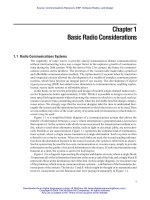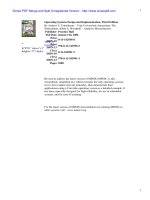budgeting basics and beyond third edition
Bạn đang xem bản rút gọn của tài liệu. Xem và tải ngay bản đầy đủ của tài liệu tại đây (2.66 MB, 450 trang )
Budgeting Basics
and Beyond
THIRD EDITION
Jae K. Shim
Joel G. Siegel
John Wiley & Sons, Inc.
ffirs.indd iiiffirs.indd iii 9/9/08 10:10:11 AM9/9/08 10:10:11 AM
ffirs.indd iiffirs.indd ii 9/9/08 10:10:11 AM9/9/08 10:10:11 AM
Budgeting Basics
and Beyond
THIRD EDITION
ffirs.indd iffirs.indd i 9/9/08 10:10:10 AM9/9/08 10:10:10 AM
ffirs.indd iiffirs.indd ii 9/9/08 10:10:11 AM9/9/08 10:10:11 AM
Budgeting Basics
and Beyond
THIRD EDITION
Jae K. Shim
Joel G. Siegel
John Wiley & Sons, Inc.
ffirs.indd iiiffirs.indd iii 9/9/08 10:10:11 AM9/9/08 10:10:11 AM
This book is printed on acid-free paper.
Copyright © 2009 by John Wiley & Sons, Inc All rights reserved.
Published by John Wiley & Sons, Inc., Hoboken, New Jersey.
Published simultaneously in Canada.
No part of this publication may be reproduced, stored in a retrieval system, or transmitted
in any form or by any means, electronic, mechanical, photocopying, recording, scanning,
or otherwise, except as permitted under Section 107 or 108 of the 1976 United States
Copyright Act, without either the prior written permission of the Publisher, or authoriza-
tion through payment of the appropriate per-copy fee to the Copyright Clearance Center,
Inc., 222 Rosewood Drive, Danvers, MA 01923, 978-750-8400, fax 978-646-8600, or
on the web at www.copyright.com. Requests to the Publisher for permission should be
addressed to the Permissions Department, John Wiley & Sons, Inc., 111 River Street,
Hoboken, NJ 07030, 201-748-6011, fax 201-748-6008, or online at ey
.com/go/permissions.
Limit of Liability/Disclaimer of Warranty: While the publisher and author have used
their best efforts in preparing this book, they make no representations or warranties with
respect to the accuracy or completeness of the contents of this book and specifically
disclaim any implied warranties of merchantability or fitness for a particular purpose. No
warranty may be created or extended by sales representatives or written sales materials.
The advice and strategies contained herein may not be suitable for your situation. You
should consult with a professional where appropriate. Neither the publisher nor author
shall be liable for any loss of profit or any other commercial damages, including but not
limited to special, incidental, consequential, or other damages.
For general information on our other products and services, or technical support, please
contact our Customer Care Department within the United States at 800-762-2974, outside
the United States at 317-572-3993 or fax 317-572-4002.
Wiley also publishes its books in a variety of electronic formats. Some content that
appears in print may not be available in electronic books.
For more information about Wiley products, visit our Web site at .
Library of Congress Cataloging-in-Publication Data:
Shim, Jae K.
Budgeting basics and beyond/Jae K. Shim, Joel G. Siegel.—3rd ed.
p. cm.
Includes index.
ISBN 978-0-470-38968-3 (pbk.)
1. Budget in business. I. Siegel, Joel G. II. Title.
HG4028.B8S558 2009
658.15'4—dc22
2008025013
Printed in the United States of America
10 9 8 7 6 5 4 3 2 1
ffirs.indd ivffirs.indd iv 9/9/08 10:10:11 AM9/9/08 10:10:11 AM
v
Contents
About the Authors vii
Preface ix
1 The What and Why of Budgeting: An Introduction 1
2 Strategic Planning and Budgeting: Process, Preparation
and Control 21
3 Administering the Budget: Reports, Analyses,
and Evaluations 35
4 Break-even and Contribution Margin Analysis: Profit,
Cost, and Volume Changes 45
5 Profit Planning: Targeting and Reaching Achievable Goals 61
6 Master Budget: Genesis of Financial Forecasting and
Profit Planning 75
7 Cost Behavior: Emphasis on Flexible Budgets 95
8 Evaluating Performance: The Use of Variance Analysis 105
9 Manufacturing Costs: Sales Forecasts and
Realistic Budgets 155
10 Marketing: Budgeting for Sales, Advertising,
and Distribution 167
11 Research and Development: Budgets for a Long-term Plan 185
12 General and Administrative Costs: Budgets for Maximum
Productivity 197
13 Capital Expenditures: Assets to Be Bought, Sold,
and Discarded 201
ftoc.indd vftoc.indd v 9/9/08 10:10:42 AM9/9/08 10:10:42 AM
14 Forecasting and Planning: Reducing Risk in
Decision Making 225
15 Moving Averages and Smoothing Techniques:
Quantitative Forecasting 233
16 Regression Analysis: Popular Sales Forecast System 243
17 Cash Budgeting and Forecasting Cash Flow:
Two Pragmatic Methods 253
18 Financial Modeling: Tools for Budgeting
and Profit Planning 265
19 Software Packages: Computer-based Models
and Spreadsheet Software 277
20 Capital Budgeting: Selecting the Optimum
Long-term Investment 289
21 Zero-base Budgeting: Priority Budgeting for
Best Resource Allocation 321
22 Managers’ Performance and Balanced Scorecard:
Evaluation on the Division Level 329
23 Budgeting for Service Organizations: Special Features 359
24 Budgeting for Nonprofit Organizations: Diverse Types 367
25 Using Management Games for Executive Training 387
Appendix I Present and Future Value Tables 405
Appendix II Statistical Table 411
Glossary of Budgeting and Planning Terms 413
Index 427
vi / Contents
ftoc.indd viftoc.indd vi 9/9/08 10:10:43 AM9/9/08 10:10:43 AM
vii
About the Authors
J
AE K. SHIM is a professor of accounting and finance at California State
University, Long Beach and CEO of Delta Consulting Company, a financial
consulting and training firm. Dr. Shim received his M.B.A. and Ph.D. degrees from
the University of California at Berkeley (Haas School of Business). Dr. Shim has
been a consultant to commercial and nonprofit organizations for over 30 years.
Dr. Shim has over 50 college and professional books to his credit, including,
Managerial Accounting, Barron ’ s Accounting Handbook, Barron ’ s Dictionary
of Accounting Terms, 2009 GAAP, Encyclopedic Dictionary of Accounting and
Finance, 2008 – 2009 Corporate Controller ’ s Handbook of Financial Management,
U.S. Master Finance Guide, Dictionary of Personal Finance, Investment Source-
book, Dictionary of Real Estate, Dictionary of International Investment Terms,
Dictionary of Business Terms, The Vest - Pocket CPA, The Vest - Pocket CFO, and
the best - selling Vest - Pocket MBA.
Twenty-six of his publications have been translated into foreign languages such
as Chinese, Spanish, Russian, Polish, Croatian, Italian, Japanese, and Korean.
Professor Shim ’ s books have been published by Thompson - Southwestern, John
Wiley, McGraw - Hill, Barron ’ s, Commercial Clearing House (CCH), Prentice -
Hall, American Management Association (Amacom), and the American Institute
of CPAs (AICPA).
Dr. Shim has been frequently quoted by such media as the Los Angeles Times,
Orange County Register, Business Start - ups, Personal Finance, and Money Radio.
Dr. Shim has also published numerous articles in professional and academic
journals. He was the recipient of the Financial Management Association Inter-
national ’ s 1982 Credit Research Foundation Award for his article on cash flow
forecasting and financial modeling.
Joel G. Siegel, Ph.D., CPA, is a financial consultant and professor of account-
ing and finance at Queens College of the City University of New York.
He was previously employed by Coopers and Lybrand, CPAs, and Arthur
Andersen, CPAs. Dr. Siegel has acted as a consultant to many organizations
including Citicorp, International Telephone and Telegraph, United Technologies,
American Institute of CPAs, and Person - Wolinsky Associates.
Dr. Siegel is the author of 67 books and about 300 articles on accounting and
financial topics. His books have been published by Prentice Hall, McGraw - Hill,
fbetw.indd viifbetw.indd vii 9/9/08 7:29:39 PM9/9/08 7:29:39 PM
viii / About the Authors
Harper Collins, John Wiley & Sons, Inc., Macmillan, International Publishing,
Barron ’ s, Southwestern, Aspen, Richard Irwin, Probus, American Management
Association, and the American Institute of CPAs.
Dr. Siegel ’ s articles have been published in many accounting and financial
journals including Financial Executive, The Financial Analysts Journal, The CPA
Journal, Practical Accountant, and the National Public Accountant.
In 1972, he was the recipient of the Outstanding Educator of America Award.
Dr. Siegel is listed in Who ’ s Where Among Writers and Who ’ s Who in the World .
His international reputation led to his appointment in 1992 as chairperson of the
National Oversight Board.
fbetw.indd viiifbetw.indd viii 9/9/08 7:29:40 PM9/9/08 7:29:40 PM
ixix
Preface
B
etter budgets can boost your department and your career to higher levels of
performance and success. Savvy executives use the budgeting process to take
stock of their direction, refine their goals, and share their mission with their staff.
Their budgeting reveals their position in the market, places untapped resources
at their command, and motivates all employees to greater levels of productivity.
They use their budgets to propel them towards the top of their industry. This book
will show you how to get there.
Budgeting Basics and Beyond shows you how the budget can be your most
powerful tool for strategy and communications. It points out that the budget brings
into stark relief all of the factors that every manager must consider, such as indus-
try conditions, competition, degree of risk, stability of operations, capacity limi-
tations, pricing policies, turnover rates in assets, production conditions, product
line and service considerations, inventory balances and condition, trends in the
marketplace, number of employees and their technical abilities, availability and
cost of raw materials, available physical resources, technological considerations,
economy, and political aspects. Then it uncovers the role each of those factors
plays in achieving your corporate goals. And since those goals cannot be achieved
single-handedly, this book suggests ways to use the budget to help each employee
appreciate how they will contribute to the division’s profitability.
Aside from playing a vital role in creating and achieving a sound business strat-
egy, this book shows how budgets can increase your effectiveness every day of the
week. In particular, it delivers these on-the-job budgeting tools:
Techniques for preparing more accurate, realistic, and reliable estimates
Control and variance analysis devices that signal revenue, cost, and operations
thresholds
Pricing guidelines for products and services
Planning and scheduling production and related costs
Profit planning and identifying looming problems
Financial models that show the relationship among all facets of the business
Spreadsheet applications for planning, budgeting, and control purposes
■
■
■
■
■
■
■
fpref.indd ixfpref.indd ix 9/9/08 7:31:08 PM9/9/08 7:31:08 PM
Implication of active financial planning software
Sales and financial forecasting methodology
Balanced Scorecard and performance metrics
We follow the example of each of these tools with examples of how you can
use them to make a difference in your work right away. And we use step-by-step
guidelines to pinpoint what to look for, what to watch for, what to do, how to do
it, and how to apply it on the job. Through step-by-step illustration, we show how
you can put these tools to use.
We hope that you will keep Budgeting Basics and Beyond handy for easy,
quick reference and daily use.
■
■
■
x / Preface
fpref.indd xfpref.indd x 9/9/08 7:31:08 PM9/9/08 7:31:08 PM
1
1
The What and Why of
Budgeting
An Introduction
A
budget is defined as the formal expression of plans, goals, and objectives of
management that covers all aspects of operations for a designated time period.
The budget is a tool providing targets and direction. Budgets provide control over
the immediate environment, help to master the financial aspects of the job and
department, and solve problems before they occur. Budgets focus on the impor-
tance of evaluating alternative actions before decisions actually are implemented.
A budget is a financial plan to control future operations and results. It is
expressed in numbers, such as dollars, units, pounds, hours, manpower, and so on.
It is needed to operate effectively and efficiently. Budgeting, when used effectively,
is a technique resulting in systematic, productive management. Budgeting facili-
tates control and communication and also provides motivation to employees.
Budgeting allocates funds to achieve desired outcomes. A budget may span any
period of time. It may be short term (one year or less, which is usually the case),
intermediate term (two to three years), or long term (three years or more). Short -
term budgets provide greater detail and specifics. Intermediate budgets examine
the projects the company currently is undertaking and start the programs neces-
sary to achieve long - term objectives. Long - term plans are very broad and may be
translated into short - term plans. The budget period varies according to its objec-
tives, use, and the dependability of the data used to prepare it. The budget period
is contingent on business risk, sales and operating stability, production methods,
and length of the processing cycle.
There is a definite relationship between long - range planning and short - term
business plans. The ability to meet near - term budget goals will move the busi-
ness in the direction of accomplishing long - term objectives. Budgeting is done
for the company as a whole, as well as for its component segments including divi-
sions, departments, products, projects, services, manpower, and geographic areas.
c01.indd Sec1:1c01.indd Sec1:1 9/9/08 10:18:06 AM9/9/08 10:18:06 AM
2 / Budgeting Basics and Beyond
Budgets aid decision making, measurement, and coordination of the efforts of the
various groups within the entity. Budgets highlight the interaction of each busi-
ness segment to the whole organization. For example, budgets are prepared for
units within a department, such as product lines; for the department itself; for the
division, which consists of a number of departments; and for the company.
Master (comprehensive) budgeting is a complete expression of the planning
operations of the company for a specific period. It is involved with both manu-
facturing and nonmanufacturing activities. Budgets should set priorities within
the organization. They may be in the form of a plan, project, or strategy. Budgets
consider external factors, such as market trends, economic conditions, and the
like. The budget should list assumptions, targeted objectives, and agenda before
number crunching begins.
The first step in creating a budget is to determine the overall or strategic goals
and strategies of the business, which are then translated into specific long - term
goals, annual budgets, and operating plans. Corporate goals include earnings
growth, cost minimization, sales, production volume, return on investment, and
product or service quality. The budget requires the analysis and study of histori-
cal information, current trends, and industry norms. Budgets may be prepared of
expected revenue, costs, profits, cash flow, production purchases, net worth, and
so on. Budgets should be prepared for all major areas of the business.
The techniques and details of preparing, reviewing, and approving budgets var-
ies among companies. The process should be tailored to each entity ’ s individual
needs. Five important areas in budgeting are planning, coordinating, directing,
analyzing, and controlling. The longer the budgeting period, the less reliable are
the estimates.
Budgets link the nonfinancial plans and controls that constitute daily manage-
rial operations with the corresponding plans and controls designed to accomplish
satisfactory earnings and financial position.
Effective budgeting requires the existence of:
Predictive ability
Clear channels of communication, authority, and responsibility
Accounting - generated accurate, reliable, and timely information
Compatibility and understandability of information
Support at all levels of the organization: upper, middle, and lower
The budget should be reviewed by a group so that there is a broad knowl-
edge base. Budget figures should be honest to ensure trust between the parties.
At the corporate level, the budget examines sales and production to estimate cor-
porate earnings and cash flow. At the department level, the budget examines the
effect of work output on costs. A departmental budget shows resources available,
when and how they will be used, and expected accomplishments.
Budgets are useful tools in allocating resources (e.g., machinery, employees),
making staff changes, scheduling production, and operating the business. Budgets
■
■
■
■
■
c01.indd Sec1:2c01.indd Sec1:2 9/9/08 10:18:06 AM9/9/08 10:18:06 AM
The What and Why of Budgeting / 3
help keep expenditures within defined limits. Consideration should be given to
alternative methods of operations.
Budgets are by departments and responsibility centers. They should reflect the
goals and objectives of each department through all levels of the organization.
Budgeting aids all departmental areas including management, marketing, person-
nel, engineering, production, distribution, and facilities.
In budgeting, consideration should be given to the company ’ s manpower and
production scheduling, labor relations, pricing, resources, new product introduc-
tion and development, raw material cycles, technological trends, inventory levels,
turnover rate, product or service obsolescence, reliability of input data, stability
of market or industry, seasonality, financing needs, and marketing and advertising.
Consideration should also be given to the economy, politics, competition, chang-
ing consumer base and taste, and market share.
Budgets should be understandable and attainable. Flexibility and innovation
is needed to allow for unexpected contingencies. Flexibility is aided by variable
budgets, supplemental budgets, authorized variances, and review and revision.
Budgets should be computerized to aid “ what - if ” analysis. Budgeting enhances
flexibility through the planning process because alternative courses of action are
considered in advance rather than forcing less - informed decisions to be made on
the spot. As one factor changes, other factors within the budget will also change.
Internal factors are controllable by the company whereas external factors usually
cannot be controlled. Internal factors include risk and product innovation.
Forecasting is predicting the outcome of events. It is an essential starting point
for budgeting. Budgeting is planning for a result and controlling to accomplish
that result. Budgeting is a tool, and its success depends on the effectiveness to
which it is used by staff. In a recessionary environment, proper budgeting can
increase the survival rate. A company may fail from sloppy or incomplete budget-
ing. Exhibit 1.1 shows a graphic depiction of budget segments.
We now consider planning, types of budgets, the budgetary process, budget
coordination, departmental budgeting, comparing actual to budgeted figures, bud-
get revision and weaknesses, control and audit, participative budgeting, and the
pros and the cons of budgets.
Planning
Budgeting is a planning and control system. It communicates to all members of
the organization what is expected of them. Planning is determining the activities
to be accomplished to achieve objectives and goals. Planning is needed so that
a company can operate its departments and segments successfully. It looks at
what should be done, how it should be done, when it should be done, and by
whom. Planning involves the determination of objectives, evaluating alternative
courses of action, and authorization to select programs. There should be a good
interface of segments within the organization.
Budgets are blueprints for projected action and a formalization of the plan-
ning process. Plans are expressed in quantitative and monetary terms. Planning is
c01.indd Sec1:3c01.indd Sec1:3 9/9/08 10:18:07 AM9/9/08 10:18:07 AM
4 / Budgeting Basics and Beyond
taking an action based on investigation, analysis, and research. Potential problems
are searched out. Budgeting induces planning in each phase of the company ’ s
operation.
A profit plan is what a company expects to follow to attain a profit goal.
Managers should be discouraged from spending their entire budget. Managers
should be given credit for cost savings.
Budget planning meetings should be held routinely to discuss such topics
as the number of staff needed, objectives, resources, and time schedules. There
should be clear communication of how the numbers are established and why, what
assumptions were made, and what the objectives are.
Types of Budgets
It is necessary to be familiar with the various types of budgets to understand the
whole picture and how these budgets interrelate. The types of budgets include mas-
ter, operating (for income statement items comprised of revenue and expenses),
financial (for balance sheet items), cash, static (fixed), flexible, capital expenditure
(facilities), and program (appropriations for specific activities such as research and
development, and advertising). These budgets are briefly explained below.
Exhibit 1.1
Budget Segments
President
Director of Sales
Investment Centers
Profit Centers
Revenue Centers
Cost Centers
Controller
Vice President
of Manufacturing
Vice President
of Marketing
Vice President
of Finance
Director
of Manufacturing
c01.indd Sec1:4c01.indd Sec1:4 9/9/08 10:18:07 AM9/9/08 10:18:07 AM
The What and Why of Budgeting / 5
Master Budget
A master budget is an overall financial and operating plan for a forthcoming
calendar or fiscal year. It is usually prepared annually or quarterly. The master
budget is really a number of subbudgets tied together to summarize the planned
activities of the business. The format of the master budget depends on the size and
nature of the business.
Operating and Financial Budgets
The operating budget deals with the costs for merchandise or services produced. The
financial budget examines the expected assets, liabilities, and stockholders ’ equity
of the business. It is needed to see the company ’ s financial health.
Cash Budget
The cash budget is for cash planning and control. It presents expected cash inflow
and outflow for a designated time period. The cash budget helps management
keep cash balances in reasonable relationship to its needs and aids in avoiding
idle cash and possible cash shortages. The cash budget typically consists of four
major sections:
1. Receipts section, which is the beginning cash balance, cash collections from
customers, and other receipts
2 . Disbursement section, comprised of all cash payments made by purpose
3 . Cash surplus or deficit section, showing the difference between cash receipts
and cash payments
4 . Financing section, providing a detailed account of the borrowings and repay-
ments expected during the period
Static (Fixed) Budget
The static (fixed) budget is budgeted figures at the expected capacity level. Allow-
ances are set forth for specific purposes with monetary limitations. It is used when
a company is relatively stable. Stability usually refers to sales. The problem with a
static budget is that it lacks the flexibility to adjust to unpredictable changes.
In industry, fixed budgets are appropriate for those departments whose work-
load does not have a direct current relationship to sales, production, or some other
volume determinant related to the department ’ s operations. The work of the depart-
ments is determined by management decision rather than by sales volume. Most
administrative, general marketing, and even manufacturing management depart-
ments are in this category. Fixed appropriations for specific projects or programs
not necessarily completed in the fiscal period also become fixed budgets to the
extent that they will be expended during the year. Examples are appropriations for
c01.indd Sec1:5c01.indd Sec1:5 9/9/08 10:18:07 AM9/9/08 10:18:07 AM
6 / Budgeting Basics and Beyond
capital expenditures, major repair projects, and specific advertising or promotional
programs.
Flexible (Expense) Budget
The flexible (expense) budget is most commonly used by companies. It allows
for variability in the business and for unexpected changes. It is dynamic in nature
rather than static. Flexible budgets adjust budget allowances to the actual activ-
ity. Flexible budgets are effective when volumes vary within a relatively narrow
range. They are easy to prepare with computerized spreadsheets such as Excel.
The four basic steps in preparing a flexible (expense) budget are:
1. Determine the relevant range over which activity is expected to fluctuate
during the coming period.
2. Analyze costs that will be incurred over the relevant range in terms of deter-
mining cost behavior patterns (variable, fixed, or mixed).
3. Separate costs by behavior, determining the formula for variable and mixed
costs.
4 . Using the formula for the variable portion of the costs, prepare a budget show-
ing what costs will be incurred at various points throughout the relevant range.
Due to uncertainties inherent in planning, three forecasts may be projected: one
at an optimistic level, one at a pessimistic or extremely conservative level, and
one at a balanced, in - between level.
Capital Expenditure Budget
The capital expenditure budget is a listing of important long - term projects to be
undertaken and capital (fixed assets such as plant and equipment) to be acquired.
The estimated cost of the project and the timing of the capital expenditures are
enumerated along with how the capital assets are to be financed. The budget-
ing period is typically for 3 to 10 years. A capital projects committee, which is
typically separate from the budget committee, may be created solely for capital
budgeting purposes.
The capital expenditures budget often classifies individual projects by objec-
tive, as for
Expansion and enhancement of existing product lines
Cost reduction and replacement
Development of new products
Health and safety expenditures
The lack of funds may prevent attractive potential projects from being
approved.
■
■
■
■
c01.indd Sec1:6c01.indd Sec1:6 9/9/08 10:18:07 AM9/9/08 10:18:07 AM
The What and Why of Budgeting / 7
An approval of a capital project typically means approval of the project in
principle. However, final approval is not automatic. To obtain final approval, a
special authorization request is prepared for the project, spelling out the proposal
in more detail. The authorization requests may be approved at various managerial
levels depending on their nature and dollar magnitude.
Program Budget
Programming is deciding on the programs to be funded and by how much. A com-
mon application of program budgets is to product lines. Resources are allocated to
accomplish a specific objective with a review of existing and new programs. Some
suitable program activities include research and development, marketing, train-
ing, preventive maintenance, engineering, and public relations. Funds usually are
allocated based on cost effectiveness. In budget negotiations, proposed budgetary
figures should be explained and justified. The program budget typically cannot be
used for control purposes because the costs shown cannot ordinarily be related to
the responsibilities of specific individuals.
Depending on needs and convenience, budgets can be classified as incremen-
tal, add - on, supplemental, bracket, stretch, strategic, activity - based, target, and/or
continuous.
Incremental Budget
Incremental budgeting looks at the increase in the budget in terms of dollars or
percentages without considering the whole accumulated body of the budget.
There are also self - contained, self - justified increments of projects. Each one
specifies resource utilization and expected benefits. A project may be segregated
into one or more increments. Additional increments are required to complete the
project. Manpower and resources are assigned to each increment.
Add - on Budget
An add - on budget is one in which previous years ’ budgets are examined and
adjusted for current information, such as inflation and employee raises. Money
is added to the budget to satisfy the new requirements. With add - on, there is no
incentive for efficiency, but competition forces one to look for new, better ways
of doing things. For example, Konica Imaging U.S.A. has combined add - on with
zero - based review.
Supplemental Budget
Supplemental budgets provide additional funding for an area not included in the
regular budget.
c01.indd Sec1:7c01.indd Sec1:7 9/9/08 10:18:08 AM9/9/08 10:18:08 AM
8 / Budgeting Basics and Beyond
Bracket Budget
A bracket budget is a contingency plan where costs are projected at higher and
lower levels than the base amount. Sales are then forecasted for these levels. The
purpose of this method is that if the base budget and the resulting sales forecast is
not achieved, the bracket budget provides management with a sense of earnings
impact and a contingency expense plan. A contingency budget may be appropriate
when there are downside risks that should be planned for, such as a sharp drop in
revenue.
Stretch Budget
A stretch budget may be considered a contingency budget on the optimistic side.
Typically it is only confined to sales and marketing projections that are higher
than estimates. It is rarely applied to expenses. Stretch targets may be held infor-
mally without making operating units accountable for them. Alternatively, stretch
targets may be official estimates for sales/marketing personnel. Expenses may be
estimated at the standard budget sales target.
Strategic Budget
Strategic budgeting integrates strategic planning and budgeting control. It is effec-
tive under conditions of uncertainty and instability.
Activity - based Budget
Activity - based budgeting budgets costs for individual activities.
Target Budget
A target budget is a plan in which categories of major expenditures are matched
to company goals . The emphasis is on formulating methods of project funding to
move the company forward. There must be strict justification for large dollars and
special project requests.
Continuous (Rolling) Budget
A continuous (rolling) budget is one that is revised on a regular (continuous)
basis. Typically, a company extends such a budget for another month or quarter
in accordance with new data as the current month or quarter ends. For example,
if the budget is for 12 months, a budget for the next 12 months will be available
continuously as each month ends. Note: Fixed budgets are criticized as being inef-
fective in a rapidly changing world. Companies report performance on a calendar
basis, but floods, stock market crashes, strikes, and a competitor ’ s new product
c01.indd Sec1:8c01.indd Sec1:8 9/9/08 10:18:08 AM9/9/08 10:18:08 AM
The What and Why of Budgeting / 9
announcement, happen continuously. In consequence, some leading companies
have abandoned fixed budgets and changed to rolling forecasts to inspire and lead
their companies to better performance. Rolling forecasts direct management ’ s
attention towards the future, and ensure that planning is ongoing, as opposed to
an annual exercise .
Budgetary Process
A sound budget process communicates organizational goals, allocates resources,
provides feedback, and motivates employees. The budgetary process should be
standardized by using budget manuals, budget forms, and formal procedures.
Software, Program Evaluation and Review Technique (PERT), and Gantt facilitate
the budgeting process and preparation. The timetable for the budget must be kept.
If the budget is a “ rush job, ” unrealistic targets may be set.
The budget process used by a company should suit its needs, be consistent with
its organizational structure, and take into account human resources. The budget-
ary process establishes goals and policies, formulates limits, enumerates resource
needs, examines specific requirements, provides flexibility, incorporates assump-
tions, and considers constraints. The budgeting process should take into account a
careful analysis of the current status of the company. The process takes longer as
the complexity of the operations increase. A budget is based on past experience
plus a change in light of the current environment.
The six steps in the budgeting process are:
1. Setting objectives
2. Analyzing available resources
3. Negotiating to estimate budget components
4. Coordinating and reviewing components
5. Obtaining final approval
6. Distributing the approved budget
A budget committee should review budget estimates from each segment, make
recommendations, revise budgeted figures as needed, and approve or disapprove
of the budget. The committee should be available for advice if a problem arises
in gathering financial data. The committee can also reconcile diverse interests of
budget preparers and users.
The success of the budgeting process requires the cooperation of all levels
within the organization. For example, without top management or operating man-
agement support, the budget will fail. Those involved in budgeting must be prop-
erly trained and guided in the objectives, benefits, steps, and procedures. There
should be adequate supervision.
The preparation of a comprehensive budget usually begins with the anticipated
volume of sales or services, which is a crucial factor that determines the level of
activity for a period. In other cases, factory capacity, the supply of labor, or the
c01.indd Sec1:9c01.indd Sec1:9 9/9/08 10:18:08 AM9/9/08 10:18:08 AM
10 / Budgeting Basics and Beyond
availability of raw materials could be the limiting factor to sales. After sales are
forecast, production costs and operating expenses can be estimated. The budgeting
period varies with the type of business, but it should be long enough to include com-
plete cycles of season, production, inventory turnover, and financial activities. Other
considerations are product or service to be rendered and regulatory requirements.
The budget guidelines prepared by top management are passed down through
successive levels in the company. Managers at each level may make additions and
provide greater detail for subordinates. The managers at each level prepare the
plans for items under their control. For example, Philip Morris formulates depart-
mental budgets for each functional area.
The budgeting process will forewarn management of possible problems that
may arise. By knowing the problems, solutions may be formulated. For example,
at the valleys in cash flow, a shortage of cash may occur. By knowing this in
advance, management may arrange for a short - term loan for the financing need
rather than face a sudden financing crisis. In a similar vein, planning allows for a
smooth manufacturing schedule to result in both lower production costs and lower
inventory levels. It avoids a crisis situation requiring overtime or high transpor-
tation charges to receive supplies ordered on a rush basis. Without proper plan-
ning, cyclical product demand needs may arise, straining resources and capacity.
Resources include material, labor, and storage.
Bottom - up Versus Top - down
A budget plans for future business actions. Managers prefer a participative
bottom - up approach to an authoritative top - down approach. The bottom - up
method begins at the bottom or operating (departmental) level based on the
objectives of the segment. However, operating levels must satisfy the overall
company goals. Each department prepares its own budget (such as estimates of
component activities and product lines by department) before it is integrated into
the master budget.
Managers are more motivated to achieve budgeted goals when they are involved
in budget preparation. A broad level of participation usually leads to greater sup-
port for the budget and the entity as a whole, as well as greater understanding of
what is to be accomplished. Advantages of a participative budget include greater
accuracy of budget estimates. Managers with immediate operational responsibil-
ity for activities have a better understanding of what results can be achieved and
at what costs. Also, managers cannot blame unrealistic goals as an excuse for not
achieving budget expectations when they have helped to establish those goals.
Despite the involvement of lower - level managers, top management still must par-
ticipate in the budget process to ensure that the combined goals of the various
departments are consistent with profitability objectives of the company.
The goals may include growth rates, manpower needs, minimum return on
investment, and pricing. In effect, departmental budgets are used to determine the
organizational budget. The budget is reviewed, adjusted if necessary, and approved
c01.indd Sec1:10c01.indd Sec1:10 9/9/08 10:18:09 AM9/9/08 10:18:09 AM
The What and Why of Budgeting / 11
at each higher level. The bottom - up approach would forecast sales by product or
other category, then by company sales, and then by market share. The bottom - up
method may be used to increase the feeling of unit - level ownership in the budget.
Disadvantages are the time - consuming process from participative input and the
fact that operating units may neglect some company objectives. Bottom - up does
not allow for control of the process, and the resulting budget is likely to be unbal-
anced with regard to the relationship of expenses to revenue.
Typical questions to answer when preparing a bottom - up budget are: What are
the expected promotional and travel expenses for the coming period? What staff
requirements will be needed? What are the expected raises for the coming year?
What quantity of supplies will be needed?
This approach is particularly necessary when responsibility unit managers
are expected to be very innovative. Unit managers know what must be achieved,
where the opportunities are, what problem areas must be resolved, and where
resources must be allocated.
In the top - down approach, a central corporate staff under the chief executive
officer or president determines overall company objectives and strategies, enumer-
ates resource constraints, considers competition, prepares the budget, and makes
allocations. Management considers the competitive and economic environment.
Top management knows the company ’ s objectives, strategies, resources, strengths,
and weaknesses. Departmental objectives follow from the action plans.
Top - down is commonly used in long - range planning. A top - down approach is
needed for a company having significant interdependence among operating units
to enhance coordination. The top - down approach first would forecast sales based
on an examination of the economy, then the company ’ s share of the market and
the company ’ s sales, and then sales by products or other category. A top - down
approach may be needed when business unit managers must be given specific
performance objectives due to a crisis situation and when close coordination
is required between business units. It is possible that the sum of the unit bud-
gets would not meet corporate expectations. If unit managers develop budgets
independently of other units, there are inconsistencies in the assumptions used by
different units.
A disadvantage with this approach is that central staff may not have all the
knowledge needed to prepare the budget within every segment of the organiza-
tion. Managers at the operating levels are more knowledgeable and familiar with
the segment ’ s operations. Managers will not support or commit to a budget they
were not involved in preparing, which will cause a motivational problem. Further,
the top - down approach stifles creativity. A budget needs input from affected man-
agers, but top management knows the overall picture.
A combination of the bottom - up and top - down approaches may be appro-
priate in certain cases. Some large companies may integrate the methods. For
example, Konica Imaging uses whichever method fits best. The company uses
a blend. Direction is supplied from the top, and senior management develops
action plans. Each department must then determine how it will actually implement
the plan, specifically looking at the resources and expenditures required. This is
c01.indd Sec1:11c01.indd Sec1:11 9/9/08 10:18:09 AM9/9/08 10:18:09 AM
12 / Budgeting Basics and Beyond
the quantification of the action plans into dollars. It is then reviewed to see if it
achieves the desired results. If it does not, it will be kicked back until it is brought
in line with the desired outcomes. The what, why, and when is specified from the
top, and the how and who is specified from the bottom.
As an example of the budgeting process, Power Cord and Cable Corporation
(PCCC) uses a comprehensive or master budget to summarize the objective of
all its subunits such as Sales, Production, Marketing, Administrative, Purchasing
and Finance. Like all organizations, PCCC uses a master budget as a blueprint for
planned operations in a particular time period.
Budget Coordination
There should be one person responsible for centralized control over the budget
who must work closely with general management and department heads. A budget
is a quantitative plan of action that aids in coordination and implementation. The
budget communicates objectives to all the departments within the company.
The budget presents upper management with coordinated and summarized data as
to the financial ramifications of plans and actions of various departments and units
within the company.
Budgets usually are established for all departments and major segments in the
company. The budget must be comprehensive, including all interrelated depart-
ments. The budget process should receive input from all departments so there is
coordination within the firm. For example, operations will improve when market-
ing, purchasing, personnel, and finance departments cooperate.
Coordination involves obtaining and organizing the needed personnel, equip-
ment, and materials to carry out the business. A budget aids in coordination
between separate activity units to ensure that all parts of the company are in bal-
ance with each other and know how they fit in. It discloses weaknesses in the
organizational structure. The budget communicates to staff what is expected of
them. It allows for a consensus of ideas, strategies, and direction.
The interdependencies between departments and activities must be consid-
ered in a budget. For example, the sales manager depends on sufficient units pro-
duced in the production department. Production depends on how many units can
be sold. Most budget components are affected by other components. For example,
most components are impacted by expected sales volume and inventory levels,
while purchases are based on expected production and raw material inventories.
A budget allows for directing and control. Directing means supervising the
activities to ensure they are carried out in an effective and efficient manner within
time and cost constraints. Controlling involves measuring the progress of resources
and personnel to accomplish a desired objective. A comparison is made between
actual results and budgeting estimates to identify problems needing attention.
In summation, the budget must consider the requirements of each department
or function and the relationship that departments or functions have with other
departments and functions. Activities and resources have to be coordinated.
c01.indd Sec1:12c01.indd Sec1:12 9/9/08 10:18:10 AM9/9/08 10:18:10 AM
The What and Why of Budgeting / 13
Departmental Budgeting
All department managers within a company must accurately determine their future
costs and must plan activities to accomplish corporate objectives. Departmen-
tal supervisors must have a significant input into budgeting costs and revenues
because these people are directly involved with the activity and have the best
knowledge of it. Managers must examine whether their budgetary assumptions
and estimates are reasonable. Budget targets should match manager responsibili-
ties. At the departmental level, the budget considers the expected work output and
translates it into estimated future costs.
Budgets are needed for each department. The sales department must forecast
future sales volume of each product or service as well as the selling price. It
probably will budget revenue by sales territory and customer. It will also bud-
get costs such as wages, promotion and entertainment, and travel. The produc-
tion department must estimate future costs to produce the product or service and
the cost per unit. The production manager may have to budget work during the
manufacturing activity so the work flow continues smoothly. The purchasing
department will budget units and dollar purchases. There may be a breakdown
by supplier. There will be a cost budget for salaries, supplies, rent, and so on.
The stores department will budget its costs for holding inventory. There may be
a breakdown of products into categories. The finance department must estimate
how much money will be received and where it will be spent to determine cash
adequacy. An illustrative budget showing revenue and expense by product line
appears in Exhibit 1.2 .
Actual Costs Versus Budget Costs
A budget provides an early warning of impending problems. The effectiveness of
a budget depends on how sound and accurate the estimates are. The planning must
take all factors into account in a realistic way. The budget figures may be inac-
curate because of such factors as economic problems, political unrest, competitive
shifts in the industry, introduction of new products, and regulatory changes.
At the beginning of the period, the budget is a plan. At the end of the period,
the budget is a control instrument to assist management in measuring its perfor-
mance against the plan so as to improve future performance. Budgeted revenue
and costs are compared to actual revenue and costs to determine variances. A
determination has to be made whether the variances are controllable or uncontrol-
lable. If controllable, the parties responsible must be identified. Action must be
taken to correct any problems.
A comparison should be made between actual costs at actual activity to bud-
geted costs at actual activity. In this way, there is a common base of comparison.
The percentage and dollar difference between the budget and actual figures should
be shown. A typical performance report for a division appears in Exhibit 1.3 .
Authorized variances in cost budgets allow for an increase in the initial bud-
get for unfavorable variances. This increase may result from unexpected wage
c01.indd Sec1:13c01.indd Sec1:13 9/9/08 10:18:10 AM9/9/08 10:18:10 AM









